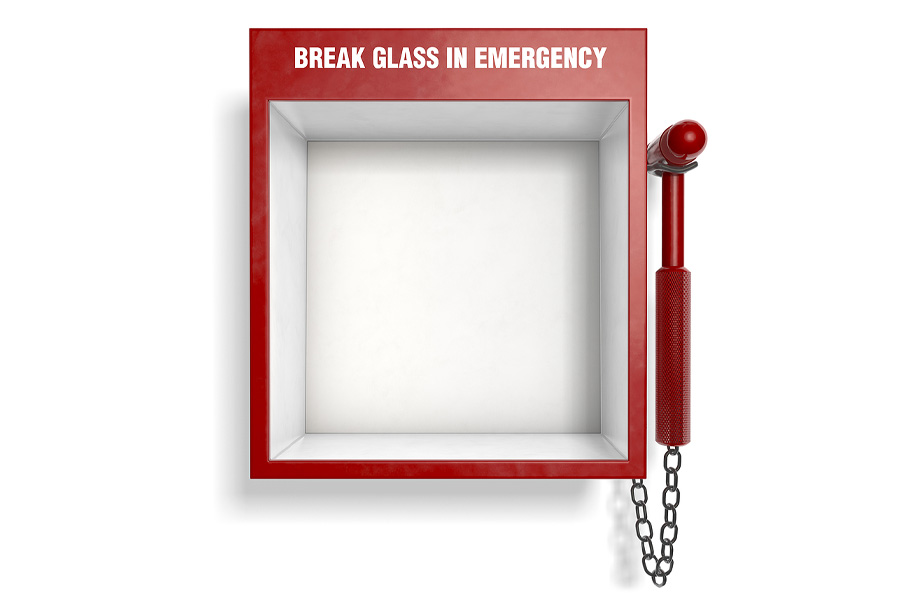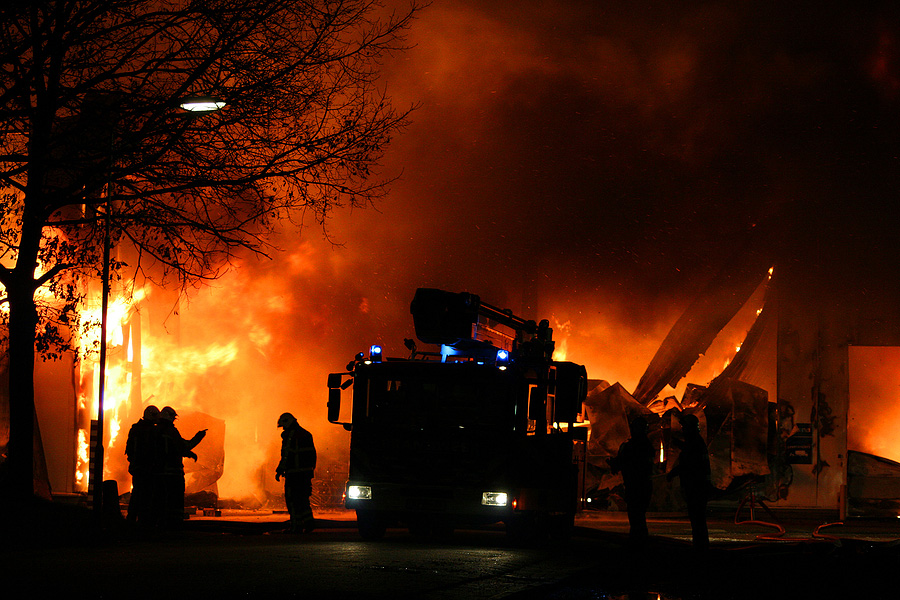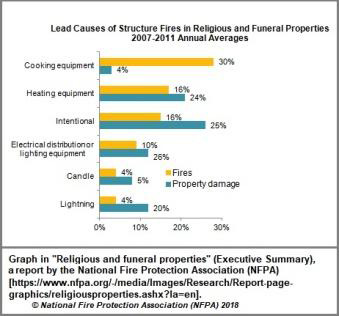Fire Safety in the Church

An Article based on the Safety Member Certification training module "Arson and Fire Safety."[1]
From the Bible
Isaiah prophesied the burning of the Temple more than 100 years before it happened. Church fires today sound like echoes of that sad incident.
Our holy and our beautiful house, where our fathers praised thee, is burned up with fire: and all our pleasant things are laid waste (Isaiah 64:11).
And they burnt the house of God, and brake down the wall of Jerusalem, and burnt all the palaces thereof with fire, and destroyed all the goodly vessels thereof (2 Chronicles 36:19).
Introduction
Fires can be devastating when they destroy the place where you live, work, shop, study, or worship. Fires can also be dangerous to occupants of the buildings and to neighbors and passersby. They are also dangerous to firefighters - such as the four Seattle firefighters who perished in a warehouse arson fire in January 1995.[2]
In the News
Spencer, Massachusetts, June 5, 2023 - A church built in 1862 was destroyed by fire on a Monday. The historic building was all wood. Smoke from the fire was seen from surrounding towns. The inferno was ignited by lightning.[3]
Columbia, Missouri, July 3, 2023 - At 4:00 am, a fire alarm triggered an alert at the Columbia fire department. They arrived at a downtown church to find that sprinklers had already extinguished the fire, leaving $200,000 of smoke and water damage. Since no one had been in the building, there were no injuries.
Firefighters originally reported that the fire was caused by sound equipment on the stage of the multipurpose room (where the fire had been). However, surveillance camera footage revealed that an unextinguished candle from a Sunday evening event caused the blaze.[4][5]

North East, Pennsylvania, September 30, 2023 - A Saturday night fire in a North East church was controlled in close to 20 minutes. The cause was found to be electrical.[6]
Lawrence, Nebraska, October 12 - A church in Lawrence was being renovated. It was almost completed when a fire broke out. The building suffered extensive smoke damage, and part of a floor collapsed. The cause was oily stain rags igniting through spontaneous combustion.[7]
Des Moines, Iowa, June 19, 2023 - About 3 pm on a Monday afternoon, a fire was reported at a Des Moines church. It had spread from near a front window to the gable, then into the roof and attic. Because of where it began, officials immediately suspected arson and brought in an arson detection dog. The dog detected accelerants in the church and at the window. Neighborhood surveillance footage showed suspicious behavior by a suspect who was later arrested and charged with arson. The suspect had a criminal record, including robbery, violence, and contempt of a magistrate.[8]
Tips for Church Fire Safety
How do we protect churches and congregants from fire? Among the considerations are the cause, the type of fire, where the fire is, who and where the people are in the building, how to not lose vital records and historical documents, and what our resources are for dealing with a fire. We can categorize this as:
- Prevention
- Suppression
- Evacuation
- Preservation
Prevention
To prevent a fire we need to know what causes fires. The causes of church fires in the news stories above are not the only ones, but four of them are common: lightning, candles, electrical problems, and arson. Other common causes are space heaters too close to flammables, furnace malfunction, kitchen fires, and smoking carelessness.
Causes of Church Fires

In 2018, the National Fire Protection Association (NFPA) published a graphic chart showing the annual averages in 2007-2011 of the leading causes of structure fires in religious and funeral properties. The graph has two bars for each cause: the percentage of fires and the percentage of the cost of property damage. While the leading cause by number of fires was cooking equipment (30%), it caused the least amount of damage (4%). The next two leading causes by number of fires were heating equipment (this also includes space heaters) and intentional (arson) at 16% each. They also caused the 2nd and 3rd largest percentages of damage (heating 24% and arson 25%). The greatest percentage of damage was electrical distribution and lighting equipment (26%). Two more causes listed were candles and lightning (4% each by number, 6% and 20% by damage).[9]
This NFPA report is no longer available. We hope to get new statistics.
A cause of church fires not on the list has been wildfires. This apparently has increased in recent years, especially in California, Tennessee, and Hawaii, while large wildfires in general have become more frequent. Churches cannot prevent wildfires, but they can reduce the potential damage from them with fire-resistant construction and smart landscaping.
Countering Causes of Fire: a Checklist
Here the motto is, "An ounce of prevention is worth a pound of cure" (this saying was coined by Benjamin Franklin to motivate fire prevention). Here are ten tips for preventing fires in the church.
- Good Housekeeping - Keep the place cleaned:
- Sweep up debris.
- Empty the trash, both outside and inside (much of it is fuel for fires).
- Keep all flammables away from heat sources - this includes class, holiday, and event decorations.
- Have the heating system inspected and serviced each year before cold weather comes.
- Use space heaters cautiously.
- Only use them when and where they are monitored.
- Don't use them if they are faulty.
- Deter arson:
- Don't leave items to start a fire lying around, especially flammable liquids and yard debris.
- Use strong access control to keep vandals and arsonists out. This includes fixing broken windows.
- Practice electrical safety. The cause of the church fire in North East, PA, was electrical.
- Check electrical equipment regularly. Fix or replace when needed.
- Update the wiring if it is too old.
- Don't overload circuits. This is a major cause of fires.
- Don't run electric cords under rugs. Use cable protectors for cords that cross walking routes or rooms (this also prevents tripping over the cords).
- Promote fire-safe practices in the church kitchen:
- Light gas burners safely, according to posted directions.
- Monitor everything cooking on the range or in the oven.
- Turn off all heating appliances before leaving the kitchen unattended.
- Use deep-fat fryers with caution.
- Use candles safely:
- Use electric candles when you can.
- Don't let children use them without supervision.
- Be sure all candles are extinguished at the end of an event. Store them in fire-proof containers.
- Don't leave matches or lighters lying around.
- Store flammable liquids safely:
- Not near a heat source.
- Locked when not in use.
- In a secure out building if possible.
- Some people will smoke. Post "No Smoking" inside, mark an area outside for smoking, and provide safe depositories for cigarette/cigar butts and pipe ashes.
- Have a properly installed lightning arrestor. It has to be capable of carrying a strong lightning strike and be well grounded. The church in Spencer, MA, was destroyed by lightning.[3]
Suppression
What if prevention does not work?
Prevention is not always 100%. If a fire starts, remember the acronym R.A.C.E.
- Rescue
- Alert
- Confine
- Evacuate / Extinguish*
* This is from the training course.
Rescue: get people out of the area or room with the fire. If someone is on fire, react calmly. Wrap them in a blanket, place them on their side, and roll them to smother the flames. Keep them calm and get emergency medical help.
Alert: Know where the alarms are and how to use them. Call 911. Give the operator your name and the location (name and address of the church). Stay on the phone with the operator until they hang up. Also tell Safety Team members of the fire, where it is, and how big it is.
Confine: You want to (1) block or slow down the spread of the fire, and (2) starve it of oxygen. Close windows and doors in the room (if you can do this safely). Now check each fire door you reach and see whether it closes. Be sure that evacuation routes are clear - no boxes, furniture, equipment, etc.
Evacuate / Extinguish: If the fire is small, you might be able to put it out. If so, let the rest of the team know. In most cases, the building will be evacuated. Follow the procedures used in the last fire drill.
When a fire does start, it should be put out as soon as possible. One advantage of a sprinkler system is that it will work even if no one is in the church. That's what saved the church building in Columbia, MO.[4][5] Special fire suppressors should be installed in the furnace room, the storage room for flammable liquids, and above the range and fryers in the church kitchen.
The church should have fire extinguishers placed around the church. All of the Safety Team and as many members of the congregation as possible should be trained in how to use the extinguishers. Remember P.A.S.S. -

- P - Pull the pin, remaining 10 ft. away
- A - Aim low at the base of the fire
- S - Squeeze the handle
- S - Sweep the hose from side to side*
* This is from the training course.
Team members on patrol should notice if an extinguisher looks as though it had been used or tampered with and check it out. Has it been knocked off the hook, or is it hanging at an angle? How long since they were serviced? Check the tag. Check the pressure gauge. Extinguishers should be inspected regularly by a professional.
Evacuation
This is the other "E" of R.A.C.E. Get the people out ASAP. Unless the church has only one to four rooms, this is best when planned and practiced. Using a floor plan of the building, plot the evacuation routes. They should be short distances without jamming too many people through one door. This means you should have enough exits. Routes may depend on where the fire starts, so have some alternate routes in case one exit is unusable.
Be ready to evacuate persons who cannot get out on their own: injured, blind, mobility impaired, hearing impaired (cannot hear the alarms or instructions), infants and young children. You may need special equipment - evacuation cribs and chairs, support (come-along) belts, stretchers.
Practice evacuations - hold fire drills. Include evacuating the disabled and infants. Have a designated assembly area a safe distance from the building. Check to see if anyone is left behind.
Preservation
In a fire, important records may be consumed. These may be kept in a fireproof safe/vault, but the fire may still be able to reach them if it happens when the safe storage is open. Keep copies of records and documents off-site so that if the worst happens, the church leaders can still access key records. Include historical documents, such as baptismal and marriage records, in the copies. Digital files should be backed up off-site anyway. As an additional benefit, in the case of a ransomware attack, just start over with the backed-up records - no money to the hackers.
Conclusion
Fire, as the saying goes, is a useful servant, but a fearsome master. We need to protect our churches from fire, whatever the cause, with Prevention, Suppression, Evacuation, and Preservation.
Training Resources
"Arson and Fire Safety" is one of the eight training modules in the Safety Member Certification program. Each Church Safety Team is encouraged to have all its members trained and certified. This can be through church-hosted classed (Team Certification), self-paced online instruction (Individual Certification), or live Zoom classes (Online Events).[1]
Another resource is the Church Security Guide article "Fire Safety in the Church," an overview of the subject.[9][10]
The local fire department and your church's insurance provider can guide you on fire safety. Members of the fire department can conduct a fire safety inspection of the church (which will let them know where the church is and how it is laid out in case they have to respond to a fire) and help in planning and conducting fire drills.
References
- Kris Moloney, "Arson and Fire Safety," Safety Member Certification, Sheepdog Church Security, © 2020 [https://sheepdog-church-security.thinkific.com/].
- Becky Chan, "Four Seattle firefighters die in arson blaze at Mary Pang's frozen-food warehouse on January 5, 1995," History Link, June 6, 2020 [https://www.historylink.org/File/3820].
- Frank O'Laughlin and Boston 25 News Staff, "Investigators announce cause of raging blaze that destroyed historic church in Spencer," Boston 25 News, June 5, 2023 [https://www.boston25news.com/news/local/investigators-announce-cause-raging-blaze-that-destroyed-historic-church-spencer/FFPTI4FNRZEJZA5YDNI6EMZ4CA/].
- Ryan Shiner, "Fire at United Methodist Church causes $200,000 worth of damage, no injuries reported, Columbia Fire Department says," KMIZ ABC 17 News, July 3, 2023 [https://abc17news.com/news/fire/2023/07/03/fire-at-united-methodist-church-causes-200000-worth-of-damage-no-injuries-reported-columbia-fire-department-says/].
- Euphenie Andre, "Columbia church fire cause by candle, not sound equipment," KMIZ ABC 17 News, November 12, 2023 [https://abc17news.com/news/columbia/2023/11/12/columbia-church-fire-cause-by-candle-not-sound-equipment/].
- Briaunna Malone, "Cause of North East church fire released," YourErie.com, Oct 2, 2023 [https://www.yourerie.com/news/local-news/cause-of-north-east-church-fire-released/].
- KSNB Local 4 Staff, "Spontaneous combustion blamed for Lawrence church fire: Stain rag combustion led to fire," KSNB Local 4, October 17, 2023; Updated October 18, 2023 [https://www.ksnblocal4.com/2023/10/17/spontaneous-combustion-blamed-lawrence-church-fire/].
- Beau Bowman, "Arrest made after Des Moines church fire ruled arson," KCCI, June 21, 2023 [https://www.kcci.com/article/iowa-arrest-made-after-des-moines-church-fire-ruled-arson/44292198].
- Staff, "Lead Causes of Structure Fires in Religious and Funeral properties: 2007-2011 Annual Averages," National Fire Protection Association (NFPA), 2018 [https://www.nfpa.org/media/images/Research/Report-page-graphics/religiousproperties.ashx?la=en].
- Kris Moloney, Church Security Guide, Sheepdog Church Security, © Copyright 2018 [https://sheepdogchurchsecurity.net/church-security-guide/].
- Kris Moloney, "Fire Safety in the Church," Church Security Guide, Sheepdog Church Security, © Copyright 2018 [https://sheepdogchurchsecurity.net/fire-safety-and-evacuations].




